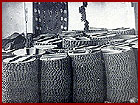|

World War I created conditions of protectionism in Greek agricultural products due to the interruption of international trade and the imposition of the allied boycott in 1916-17.  As a result, even the prices of domestic agricultural products rose steeply and the volume of agricultural production increased. At the same time, the National Defence government of Thessaloniki, in its effort to become stronger on the domestic front by winning the support of landless farmers, it implemented on May 20, 1917 measures of Agrarian Reform by expropriating big estates ("tsiflikia"). These measures were practically put into action by the government of the "Revolution of 1922". Therefore, in 1918 only one estate was expropriated and 63 in 1920, whereas 1203 estates were expropriated between 1923 and 1925. Until the Reform was completed 8,311,723,000 square metres of privately-owned land had been distributed to approximately 600,000 refugees. The abolition of large landed properties decreased significantly the usury as a principal source of agricultural credits. This role was assumed from 1923 mainly by the National Bank of Greece. As a result, even the prices of domestic agricultural products rose steeply and the volume of agricultural production increased. At the same time, the National Defence government of Thessaloniki, in its effort to become stronger on the domestic front by winning the support of landless farmers, it implemented on May 20, 1917 measures of Agrarian Reform by expropriating big estates ("tsiflikia"). These measures were practically put into action by the government of the "Revolution of 1922". Therefore, in 1918 only one estate was expropriated and 63 in 1920, whereas 1203 estates were expropriated between 1923 and 1925. Until the Reform was completed 8,311,723,000 square metres of privately-owned land had been distributed to approximately 600,000 refugees. The abolition of large landed properties decreased significantly the usury as a principal source of agricultural credits. This role was assumed from 1923 mainly by the National Bank of Greece.
From 1923 there was a fall in the prices of agricultural products, so that new landowners would make active efforts to increase production, in order to deal with their various economic obligations. Thanks to the refugees the improvement and increase of tobacco production was appreciable. Cultivable land increased from 12,883,150,000 square metres (annual average of the period 1914-22) to 14,903,190,000 (annual average of the period 1923-28). Wheat production increased overall by 25%. |


